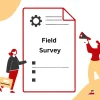
Future of Feedback: QR Code for Business Growth
Imagine this: a customer, excited about a recent purchase, wants to leave feedback but is met with a dauntingly long survey. Frustration sets in as they abandon the task. With their lengthy forms and inconvenient processes, traditional feedback methods often lead to low participation rates and limited, less actionable data.
Enter QR codes Insights—the game-changer in the feedback arena. These quick-response codes are fast, easy to use, and can unlock a wealth of data. This article explores how businesses can leverage QR codes to gain valuable customer insights and optimize operations.
The Power Of QR Code Feedback
QR codes are revolutionizing how businesses gather customer insights. Gone are the days of lengthy paper surveys or inconvenient online forms. Customers can instantly access feedback mechanisms, eliminating frustration and boosting participation rates with a simple scan using their smartphone camera.
Furthermore, QR codes eliminate accessibility barriers. Unlike traditional methods requiring internet access or physical forms, QR codes allow customers to provide input at their convenience, anytime and anywhere.
Interactive Options
The power of QR codes goes beyond simply triggering basic surveys. They can unlock a variety of interactive feedback mechanisms, catering to different customer preferences. Businesses can utilize QR codes to launch polls, detailed surveys, or even open-ended feedback forms. These options can be further enhanced by integrating with chatbots or SMS, allowing for real-time interaction and immediate issue resolution.
Many customer service software examples offer features that seamlessly integrate with QR code feedback. These platforms can manage the various interactive options, analyze the collected data, and even trigger automated responses based on customer input. Leveraging these integrations empowers, businesses to create a more responsive and efficient feedback system that ultimately improves customer satisfaction.
Data-Driven Decisions: Unlocking Customer Insights
Data-driven decisions help businesses understand customer needs by analyzing real-time feedback and behavior. These insights guide better strategies and improve overall customer experiences
1. Unveiling Customer Demographics
QR codes go beyond just collecting feedback; they also provide businesses with valuable customer insights. Each scan reveals data like location and user demographics. Imagine a clothing store noticing a surge in QR code scans from a particular neighborhood.
The 2023 QR Code Trends Report reveals a 41% global increase in QR code usage by businesses and brands compared to 2022. The Retail and Consumer Packaged Goods (CPG) sectors saw an 88% rise in QR code creations as the industry shifted from traditional to 2D barcodes.
2. Actionable Insights & Analytics
But QR codes offer more than just demographics. Powerful QR code analytics can reveal trends, measure campaign effectiveness, and personalize future interactions. Businesses can analyze scan data to identify which products or services resonate most with customers, gauge overall satisfaction, and adjust strategies based on real-time feedback.
For example, a public service organization uses QR code analytics to see which community programs generate the most feedback. This data can help them prioritize improvements and tailor future initiatives based on community needs.
Strategic QR Code Implementation: A Multi-Channel Approach
Strategic QR code implementation involves using QR codes across various channels to enhance customer engagement and streamline interactions. A multi-channel approach ensures seamless integration across physical, digital, and social platforms.
1. Integrating QR Codes Across Touchpoints
Don’t limit QR codes to just one place. They can be easily added to various marketing materials, from brochures and product labels to social media posts and online ads. This multi-channel approach gives customers more chances to provide feedback at different points in their journey with your business.
Get creative with QR code placement. Put them on receipts for quick feedback after a purchase, incorporate them into eye-catching store displays, or add them to your email signatures for easy access.
2. QR Codes Throughout The Customer Journey
Businesses can use QR codes at the different customer journey stages, from product registration and warranty claims to post-purchase experiences. For example, a QR code on a product’s packaging could direct customers to a quick satisfaction survey, while another on a warranty card could streamline the registration process.
This approach can be precious in the education management sector. Imagine a school using QR codes on student progress reports. Parents could scan the code for a detailed breakdown of their child’s performance, potentially including interactive graphs or links to additional resources.
Building Brand Loyalty With QR Code Feedback
Responding to customer feedback isn’t just about hearing their voices; it’s about taking action and showing them it matters. QR codes can streamline this process, creating a closed-loop feedback system.
This cycle demonstrates that their opinions are valued and acted upon, building trust and loyalty. Imagine mall operators and tenants using QR codes to gather feedback on its facilities and services. By promptly addressing negative comments and thanking customers for positive ones, the mall shows it cares about the shopping experience, fostering stronger customer relationships.
Demonstrating Customer Appreciation
QR code feedback can be a powerful tool for showing customer appreciation and boosting loyalty, as in healthcare organizations.
Imagine a hospital sending personalized thank-you messages and offering exclusive discounts to patients and families who provided valuable feedback via QR code. This shows the hospital listens and wants to reward their participation.
Emerging Applications Of QR Code Feedback
QR codes are no longer limited to just surveys. They’re expanding beyond their known uses, unlocking a world of innovative ways to gather feedback and engage customers.
Imagine scanning a QR code on a high-end watch to verify its authenticity instantly. Or, picture pointing your phone at a product display and launching an augmented reality (AR) experience that lets you see the item in 3D and explore its features.
These are just a few exciting possibilities with QR codes. Businesses can collect richer data and create a more engaging customer experience by making feedback interactive and informative.
Conclusion
Leveraging QR codes for customer feedback offers numerous benefits, from increased participation and detailed insights to improved customer loyalty. Businesses that embrace this technology will gain a competitive edge, driving growth and innovation. As QR codes continue to evolve, they hold the potential to revolutionize customer feedback, creating a seamless and enriched experience. Embrace the future of feedback with QR codes and unlock the full potential of customer insights.
Frequently Asked Questions? (FAQs)
How Can QR Codes Improve Customer Feedback Participation?
QR codes make it easy for customers to provide feedback with a simple scan, eliminating the need for lengthy surveys. This convenience boosts participation rates and ensures more actionable feedback.
What Types Of Feedback Can Be Collected Through QR Codes?
QR codes can trigger a variety of feedback mechanisms, including polls, surveys, open-ended forms, and even real-time interactions via chatbots or SMS for immediate issue resolution.
How Do QR Codes Provide Valuable Customer Insights?
Each QR code scan reveals useful data such as location, demographics, and customer behavior. This data can be analyzed to tailor marketing efforts, improve services, and make data-driven business decisions.
Can QR Codes Be Integrated With Other Technologies?
Yes, QR codes can integrate with artificial intelligence (AI) and big data analytics to automate responses, track trends, and offer deeper insights into customer feedback, creating a more robust feedback system.
Enhance Patient Care and NABH Compliance with LazyMonkey
LazyMonkey is your all-in-one solution for improving patient care, retaining more patients, and meeting NABH standards. Our powerful QR-based feedback tool enables you to capture real-time insights from patient feedback, discharge surveys, staff and doctor evaluations, and clinical research, while also streamlining inter-departmental communication.
Transform your healthcare facility today - reach out to us at hello@lazymonkey.in, or request a demo here!
Elevate Your Restaurant Experience with LazyMonkey
LazyMonkey’s QR-based feedback system helps you gather real-time insights from customers, track satisfaction levels, and enhance the dining experience. Get instant feedback on your menu, service, and ambience, and make data-driven improvements to boost repeat customers and reviews.
Improve your restaurant today – reach out to us at hello@lazymonkey.in, or request a demo here!
Empower Student Engagement and Campus Improvement with LazyMonkey
LazyMonkey offers a seamless way to gather student feedback, track satisfaction, and enhance campus life. From course evaluations to dorm feedback, our QR-based solution makes it easy to capture valuable insights and improve student retention.
Upgrade your university experience – contact us at hello@lazymonkey.in, or request a demo here!
Streamline Feedback and Drive Performance Across Your Enterprise/Franchise with LazyMonkey
Whether you manage one or multiple locations, LazyMonkey’s QR-based feedback system helps you gather real-time employee and customer feedback. Improve operational efficiency, track satisfaction, and make data-driven decisions to enhance brand consistency and growth.
Transform your franchise today – reach out to us at hello@lazymonkey.in, or request a demo here!
Enhance Customer Satisfaction and Service Standards in Banking with LazyMonkey
LazyMonkey empowers banks to capture real-time feedback from clients across branches. Improve customer experience, assess service quality, and ensure regulatory compliance with our QR-based solution, helping you retain clients and meet banking standards.
Elevate your bank’s customer care – contact us at hello@lazymonkey.in, or request a demo here!
Boost Customer Engagement and Mall Satisfaction with LazyMonkey
LazyMonkey’s QR-based feedback tool enables you to collect feedback from shoppers, track satisfaction, and enhance the mall experience. Gather insights on store services, cleanliness, and entertainment to create an unmatched customer journey.














